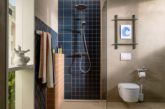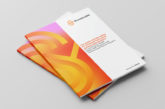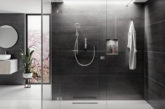
The bathroom industry has undergone significant evolution in recent years, driven by technological advancements, changing consumer preferences, and an increasing emphasis on sustainability. Andrew Shankster, Product Training Manager at Geberit UK explores key trends shaping the future of bathroom design and installation, and how industry professionals can leverage them to their advantage.
One of the most notable shifts in the industry is the move towards multi-layer piping systems. These solutions offer an alternative to traditional materials, addressing common issues such as corrosion, scaling, and heat loss. Multi-layer pipes typically consist of three layers, with a central aluminium layer sandwiched between two plastic layers. This construction offers a combination of flexibility and stability, making installation more efficient.
The benefits of multi-layer piping systems for installers are substantial. The installation process is streamlined, with no need for hot works or additional consumables on site. These systems are versatile, suitable for various applications from potable water to heating systems. Their durability, including resistance to corrosion, cracking, and scale build-up, ensures a longer service life. Furthermore, the excellent thermal insulation properties of multi-layer pipes contribute to energy efficiency, aligning with the requirements of Part L of the Building Regulations for the conservation of fuel and power.
Products such as Geberit FlowFit exemplify these advantages, offering press-fit technology that further optimises the installation process. With only two pressing jaws required for the entire range, it presents an efficient solution that can enhance productivity, particularly in confined spaces. Embracing multi-layer piping systems can differentiate installers in a competitive market, offering clients a modern, efficient solution that aligns with the growing demand for sustainable and cost-effective installations.
The rise of shower toilets
Another trend gaining significant traction is the increasing popularity of shower toilets. These advanced fixtures, which combine the functions of a toilet and a bidet, are increasingly perceived as a luxury item in residential bathrooms and are becoming more prevalent in commercial settings.
Shower toilets, such as the Geberit AquaClean Alba, offer several benefits that resonate with modern consumers: enhanced hygiene through integrated washing functions, improved comfort features like heated seats and adjustable water temperature, increased accessibility for users with mobility issues, and sustainability benefits through reduced toilet paper usage and efficient water consumption.
For installers, the growing demand for shower toilets presents an opportunity to expand their service offerings and develop expertise in high-value installations. While the installation process may require additional skills, particularly regarding electrical connections and specialised water supply requirements, mastering these systems can position installers as specialists in a growing market segment.
Concealed systems
The trend towards minimalist, spa-like bathrooms has driven demand for concealed installation systems. These behind-the-wall solutions create a sleek, uncluttered aesthetic while maximising space – a crucial consideration in modern bathroom design. Concealed cisterns for wall-hung toilets are at the forefront of this trend. While they may present initial challenges, such as accommodating uneven wall surfaces or working in compact spaces, the end result is a stylish and space-efficient solution that increasingly appeals to clients.
To successfully navigate concealed system installations, installers should familiarise themselves with adjustable mounting frames to compensate for wall irregularities, utilise manufacturer-provided templates and measuring guides for precise positioning, and consider systems designed for efficient installation, such as Geberit Sigma and Omega concealed cisterns. These products offer features like tool-free installation options and easily accessible service openings, facilitating both installation and future maintenance.
Personalised bathroom designs
Perhaps one of the most significant shifts in the industry is the growing demand for personalised, bespoke bathroom designs. Clients increasingly view their bathrooms as personal retreats and seek spaces that reflect individual styles and needs. This trend towards customisation is evident in the popularity of modular bathroom furniture and mix-and-match concepts. For example, Geberit’s Mix & Match concept allows customers to combine basins and furniture across different ranges, creating truly personalised wash places.
For installers, this trend towards bespoke designs necessitates an expanded product knowledge base, increased flexibility in working with diverse materials and installation requirements, and enhanced collaboration with designers and clients to understand and implement unique visions. It also requires problem-solving skills to overcome installation challenges that may arise from custom designs.
The importance of training
To maximise opportunities in this evolving market, installers should prioritise continuous professional development. This includes staying updated on the latest products and installation techniques through manufacturer training programmes and industry events. Investing in specialised tools for working with new materials and systems, such as press-fit tools for multi-layer piping, can enhance efficiency and capability.
Marketing strategies should be adapted to showcase expertise in trending installations, such as shower toilets or concealed systems, through digital platforms and client testimonials. Building strong relationships with suppliers who offer products aligned with these trends can provide a competitive edge and potential business referrals.
Additionally, the ability to educate clients on the benefits of new technologies and designs can be a valuable differentiator. Installers who can effectively communicate the advantages of bathroom solutions – whether it’s the improved hygiene of a shower toilet or the space-saving benefits of a concealed cistern – are better positioned to secure high-value projects.
The bathroom industry is undergoing a significant transformation, and installers have the opportunity to be at the forefront of this evolution. By embracing these trends and continually expanding their skills and knowledge, plumbing and heating professionals can offer clients bathrooms that are not only functional but also sustainable, personalised, and innovative. Adapting to these changes and positioning oneself as an expert in modern bathroom solutions can lead to business growth and success in this dynamic market.

